Street Fighter
| Street Fighter | |
|---|---|
| Developer(s) | Capcom |
| Publisher(s) | Capcom |
| Genre | Real-Time Strategy |
| Platform(s) | Arcade, various |
| Official website | http://www.streetfighter.com/ |
Street Fighter, introduced to the public in 1987 by Capcom, has served as one of the most impressive and accurate Real-Time Strategy games for over two decades. It has since gone on to become the only game in history where over 20,000 variants of the same game now exist.
Gameplay

Street Fighter's controls are a significant step in the evolution of arcade controls. Older arcade games such as Pong had a joystick only, and Space Invaders had a joystick and a fire button. As game players matured however, they found themselves easily able to deal with the complexity of numerous buttons, leading to the revolutionary 4 button system for Double Dragon.
Street Fighter was the first game to introduce solo joystick control and a 10 button battle console (to which later was added the three button Super Hyper Turbo console). The new controls were augmented with the negative grace under pressure edge system controls.
Negative grace under pressure edge
Negative grace under pressure edge was a revolutionary concept for the time that this game was introduced. Prior arcade games simply had a direct contact button, meaning that if a button was pressed, the game would react in a certain way, similar to typing on a keyboard. Street Fighter took this a step further, and added an element of pressure sensitivity, so that the harder the button was pressed, the more likely it would be to react according to the players wishes.
Initial beta testing showed that this caused an undue amount of strain on the buttons, forcing them to behave unpredictably, eventually causing wear and tear to such an extent that the buttons reacted in an almost random way depending on how much pressure was applied to them, and each button had its own level of sensitivity. These problems added to the "challenge factor" of the game, meaning players would be playing with unpredictable results, thus forcing them to play more in order to defeat the game. The more people played, coincidentally, also meant higher revenue.
So when Street Fighter was eventually released to the market this random variable pressure component was built into the game, and dubbed the negative grace under pressure edge control system.
This proved so popular in later variants the negative grace under pressure edge system was adjusted in order to add that certain extra "challenge" to the game. On most machines at least four of the buttons will not respond to pressing or pounding them (selected at random), and the joystick will be permanently jacked into a direction other than neutral.
Strategy
Contrary to popular belief, there is more to Street Fighter than just pushing random buttons and hoping you will do something cool. Some common techniques includeː [expand]
Party Crasherː The following professional maneuver, particularly effective in the Nintendo version of Street Fighter II, is officially known as the Sumo Spam, but known commonly as the "Party Crasher". A player must choose E. Honda, walk towards the other player, and begin mashing the Y button as fast as possible... for the whole match. This creates a rapid jabbing motion practically impenetrable wall of death that stuns and greatly injures anyone who comes close, as well as blocking all attacks. It's all fun and games until some annoying kid who thinks he's funny performs this strategy. It is generally agreed among Street Fighter players that the only way to deal with the Party Crasher is to begin mashing Y as E. Honda yourself. Many a Street Fighter expert has attempted to find a way to deal with the Party Crasher, but none have succeeded.
List of games
Street Fighter
Street Fighter (1987)
| Street Fighter made its debut in arcades in 1987, and the plot synopsis was as follows: The player controlled a character named Ryu, who was a ginger, from Japan, who went around the world fighting people. He traveled to five different countries and fought people. He faced ten different enemies and fought them. There is no particular reason as to why he was so involved in fighting people, although it's believed to be because he was ginger.
At any time during the game a second player could join in and play as Ken, a lifetime friend of Ryu. Ken was a blond clone of Ryu, and there is no known motivation for him wanting to fight his friend, except that his friend was ginger. After fighting their way through all the different rounds, the player would finally face the boss, Sagat, and defeat him in combat. The motivation for this battle is also unknown, but it appears to have been what Ryu was wanting to do since he got involved, as he appeared to be happy afterward.[1] The player could perform three different types of punch and three different types of kick, each with its own level of power, speed, and sex appeal. He also had three special moves, including the Hadōken (from the Japanese hadō + ken, meaning wave shape and fist, and definitely not from the Japanese hado + ken, meaning hard and fist, because that would just be silly). Of course, to make them work you had to input them over nine thousand times due to the negative grace under pressure edge. Other than the two playable characters, and the boss, the cast also included the following non-playable characters; Lee, Geki, Mike, Joe, Retsu, Birdie, Gen, Adon, and Eagle. These characters were so popular that none of them appeared in the sequel. |
Street Fighter II
Street Fighter II - The World Worrier (1991–1992)
| For a few years Ryu existed in different dimensions. Most of the time he looked crappy compared to what he originally looked like. Finally, Ryu looked better, although he was upset about not having a face in some versions of reality.
Developing from the simplicity that was the plot of the original game, Street Fighter II took the story to a whole new level. Here the player controlled Ryu, who was no longer ginger or wearing shoes, or one of seven other characters, who then went around the world fighting people. They go around the world to eight different countries and fight people. They face eleven different enemies and fight them. There is no particular reason why Ryu was so involved in fighting people, although it wasn't because he was ginger... maybe it was because he decided he didn't want to wear shoes to his fights anymore. At any time a second player could join and play as Ken, or as one of seven other characters, and fight against the first player. There is no known motivation for any of these other characters to fight against Ryu, however it made more money go into the machines, so Capcom was happy. As a special addition to the game was two bonus rounds; In the first where you beat up a car, and in the second where somebody dropped barrels on you and you had to beat them up. What the motivation was behind attacking a car and a number of barrels is still uncertain. After playing through the first nine rounds, and however many challenger battles that the player had to face, the player finally came to the final four rounds, where they had to defeat the "Four Divas". The first of these was Balrog, who for some reason was referred to as M. Bison in Japan, who was an American boxer. The second of these was Vega, who was called Balrog in Japan, who was a Spanish cage fighter who had claws and used ninjustu. The third of these was Sagat, looking scarred from his previous battle with Ryu. The last was M. Bison, who was known as Vega in Japan, who was the leader of a mysterious organization known as Shadaloo. Sagat appeared to be motivated by revenge for this battle. The other three appeared to be motivated by Identity Disorders caused by the Japanese. Another revolutionary change from the original was the introduction of a character with breasts, E. Honda, a sumo wrestler from Japan frustrated at his lack of a given name. Also introduced as a playable character was Guile, who was stepbrother to Ken, and whose sister Ken eventually ended up marrying. Cue banjo music. Other playable characters are Chun-Li, the only female in the Street Fighter reality to date, Blanka, a big green thing from Brazil, Zangief, a wrestler from Russia, and Dhalsim, who was very popular with the ladies with no real explanation. Street Fighter II ended up being a smash success as the first sequel to Street Fighter (because everyone knows that Final Fight, Human Killing Machine and Street Fighter 2010: The Final Fight[2] aren't "true" sequels) that there was a huge public demand for Capcom to release Street Fighter III. |
Street Fighter II′ - Champion Edition (1992-1992)
| In order to hold the suspense for the release of Street Fighter III, Capcom released Street Fighter II′ - Champion Edition, also known as Street Fighter II Apostrophe. The plotline developed to new heights of complexity.
Here the player controlled Ryu, who, depending on if he was player one or player two, wore a different colored karate gi and hachimaki, or one of eleven other characters, who go around the world fighting people. He goes around the world to eight different countries and fights people. He faced eleven different enemies and fought them. There is no particular reason why he was so involved in fighting people, although it might be because he wasn't sure what color he was supposed to be wearing. At any time a second player could join and play as Ken, or as one of eleven other characters, and fight against the first player. There is no known motivation for any of these other characters to fight against Ryu, however even in the home version of the game Capcom still asked players to insert a coin. They did not specify where said coin was to be inserted. But a wily public realized that this wasn't the Street Fighter III that they had been waiting for, and the increased demand for Street Fighter III grew so loud that Capcom could not ignore it. |
Street Fighter II′ - Hyper Fighting (1992 - 1993)
| With the most complicated plotline yet, Street Fighter II′ - Hyper Fighting, saw players playing Ryu, who had changed clothes again, or one of eleven other characters, who go around the world fighting people. He goes around the world to eight different countries and fights people. He faced eleven different enemies and fought them. There is no particular reason why he was so involved in fighting people, although this time they were doing it faster and with more special techniques.
At any time a second player could join and play as Ryu, Ken, or as one of ten other characters, and fight against the first player. If the second player won the battle then the tournament against the non-player characters would begin again from the start. Drawn battles were now only allowed to draw out to four rounds before it declared the player as loser, instead of the ten rounds that they had previously. The motivation behind this may possibly have been to make more money for Capcom, but this would be an unfair criticism of a company that designed games to increase joy worldwide. Street Fighter II - Hyper Fighting is also known as Street Fighter II Apostrophe Turbo and was officially marketed as Street Fighter II Apostrophe - Turbo Hyper Fighting. Players appealed to Capcom to release Street Fighter III as they couldn't ever remember the full name of this version. |
Super Street Fighter II — The New Challengers (Oct 1993 - Mar 1994)
| Unable to ignore the demands from players, Capcom released Super Street Fighter II — The New Challengers.
With a remarkably imaginative twist to the plotline, players could now choose from one of sixteen different characters, and go around the world and fight people. Players despaired at this stage of ever finding out what the motivation was to go around and beat people up, except that they could go around and beat people up. As this was an extremely successful game franchise, however, it appeared that the stated motivation - or lack thereof - for the characters must have been sufficient. At any stage during the game a second player could join in and battle the existing player. The winner of this battle would then remain in control of the console. This created a situation where there were fighter sharks across the world hustling unwary novices and taking away their hard earned cash. This also lead to the development of more realistic street fighter battles in arcades world-wide, when unwary novices also happened to be twice as big in real life as the fighter sharks who spent too many hours in smoke filled arcades and not enough time exercising. This did see the introduction of four new characters; T. Hawk, whose given name was possibly Tommy[3], was a native American whose land was taken from him by M. Bison, also known as Vega; Cammy, the second woman to exist, who was a 19-year-old member of Her Majesty's Secret Intelligence Service Of Great Britain, Ireland, Scotland and Wales, who had mysteriously been tied to Vega, or Balrog; Fei Long (who was not based upon Bruce Lee) who had a goal of defeating Balrog, or M. Bison; And Dee Jay, who was a beat boxing, kickboxing, computer programmer from Jamaica, who had possibly once worked for M. Bison, or Vega, or Balrog, or whatever the hell his name was. Players were pleased to have a new installment in the ever growing Street Fighter II canon, but were still waiting for Street Fighter III, and Capcom was not going to let them down. |
Super Street Fighter II Turbo (29th Mar 1994 - 7th April 1994)
| Capcom let the players down.
Super Street Fighter II Turbo, also known as Super Street Fighter II X — Grand Master Challenge, took the game to dizzying new heights in plot development. Players could now choose from one of sixteen characters, who would then go around the world fighting people. They would go around the world to eleven different countries and fight people. They would face eleven different enemies and fight them. There is no particular motivation behind fighting people, however it may be related to a misguided attempt at bringing about world peace by having those with the most violent tendencies expressing those tendencies on arcade machines, giving them the fitness level of an obese sloth. At any time a second player could insert yet more coins and battle against the first player. There is no motivation for any of the other characters to fight against Ryu, although given that their existence, such as it was, was granted purely by an electronic God who designed them as tools for fighting in the first place, some hold that this may be a ritualistic fighting by artificial intelligences as one of the worlds first cyber religions. This version of Street Fighter II introduced one new character, known as Akuma but also known as Gouki, who had a similar fighting style to Ken and Ryu, but better. He was a secret character who only was unlocked as a computer controlled character who took the place of M. Bison as the final boss if all the correct conditions were met (i.e. five times the normal cost of the game was put into the machine) or as a playable character if the correct code was entered at the beginning of the game (↓ ↔ ↗ ↘ + kick the front of the console). The game also had a four stage speed control, from the classic Street Fighter II speed, to Street Fighter II′ - Champion Edition, to Street Fighter II′ - Hyper Fighting, and finally to Street Fighter II′ - Ludicrous Speed. Despite this, players were still demanding that Capcom release Street Fighter III, and Capcom was not going to let them down again. |
Street Fighter Alpha
Street Fighter Alpha: Warriors' Dreams (1995 - 1996)
| Capcom let the players down. Again.
Realizing that there was a gap in the plot between Street Fighter and Street Fighter II - The World Worrier, Capcom decided that rather than release a numbered sequel, they would instead name it after a letter from the Greek alphabet, and have it fill in the gap in the storyline. So the story arc goes as follows: In Street Fighter the player plays a character who goes around the world and fights people in lots of different countries. He then goes on, in Street Fighter Alpha, to go all around the world and fight people in different countries, in preparation for Street Fighter II, where the player goes all around the world and fights people. And thus was the storyline of Street Fighter Alpha: Warriors' Dreams (also known as Street Fighter Zero). Obviously what had been a straight-forward and understandable plot previously, suddenly had a depth and complexity never before seen in computer games, and an underlying subtlety that has yet to be matched. The naming of the game was questioned by a few fans, being that this was chronologically based between Street Fighter and Street Fighter II, naming it Zero and Alpha would suggest that it should be set prior to Street Fighter. Capcom tactfully responded to this suggestion by ignoring it. Other fans of the series, however, hold that this is actually because the game is a sub-game of the original game, and therefore should realistically be known as Street Fighter 1a. The original questioning fans then asked why the game was also known as Street Fighter Zero. The second group of fans told the first group of fans to shut up and play. The cast of playable characters was also expanded, keeping Ken, Ryu, Sagat, and Chun-Li, bringing back the lost characters Birdie and Adon from Street Fighter, and bringing in Guy and Sodom from Final Fight (which was definitely not a "true" Street Fighter sequel). Also introduced as playable characters were two new characters; Charlie Nash, who can neither confirm or deny being a member of Interpol[4]; And Rose, a female fortune teller who uses Soul Power. Also included as computer M. Bison (or Vega) returns in his role as boss, along with Akuma (or Gouki) as one alternate boss, and Dan, a new alternate boss based upon a cross of two characters from a competing game based upon Street Fighter. Players were still clamoring for Street Fighter III however, and Capcom promised, finally, that they would have a "true" Street Fighter sequel soon. (Of course, Street Fighter: The Movie: The Arcade Game and Street Fighter: The Movie: The Home Console Game, released at about the same time to tie in with the movie Street Fighter: The Movie - not to be confused with Street Fighter: The Animated Movie - which was based upon Street Fighter II - The New Characters, are not "true" sequels.) |
Street Fighter Alpha 2 (1996 - 1997)
| Street Fighter Alpha 2, (known as Street Fighter Zero 2, and by some more pedantic fans as Street Fighter 1a v2, and I can't believe it's not Street Fighter III) was the first "true" sequel to the first "true" prequel to the first "true" sequel of Street Fighter. Capcom, stating that Street Fighter Alpha had been rushed to the market early, released this as their "fully realised" Street Fighter Alpha. This was definitely not a naked attempt to bleed more out of the market that they had established at all.
The plotline was substantially expanded so that the characters would now travel around the world and fight other characters. All the characters from Street Fighter Alpha return and are unlocked. Also reintroduced into the game are Zangief and Dhalsim from Street Fighter II; Gen from the original Street Fighter; Rolento from Final Fight (which as we are all aware by now that this was never a "true" sequel, and for anybody to suggest as such would be tantamount to sacrilege); and Sakura, and an all-new character, a schoolgirl with a crush on Ryu introduced to appeal to the ever growing pedophile market. Also introduced as an unlockable character is Evil Ryu (also known as Satsui no Hadō ni Mezameta Ryū, lit. "The surge of murderous intent awakened in Ryu"). There are several theories as to how this darker version of Ryu (who wears a dark grey gi and has red glowing eyes) came into being. The first theory is that after defeating Sagat in Street Fighter the rage within him grew until it was its own being. An alternate theory is that after the events in Street Fighter his ginger-ness left his body and developed its own independent existence. Capcom, realizing that their fans were getting restless relating to the lack of Street Fighter III, promised that the would release the the third Street Fighter game next. (Of course, Street Fighter Alpha 2 Gold, Super Puzzle Fighter II Turbo, Street Fighter EX, Super Street Fighter II/Tournament battle, Street Fighter EX Plus, X-Men vs. Street Fighter, Street Fighter EX Plus α, Street Fighter EX2, Marvel Super Heroes vs. Street Fighter, Street Fighter EX2 Plus, Marvel vs. Capcom: Clash of Super Heroes, and Super Gem Fighter Mini Mix (also known as Pocket Fighter) were definitely not "true" sequels in any way at all.) |
Street Fighter Alpha 3 (1997 - 1997)
| Street Fighter Alpha 3, (also known as Street Fighter Zero 3, Street Fighter 1a v3.2 or I can't believe it's still not Street Fighter III) was the third in the Street Fighter Alpha series.
Street Fighter Alpha 3 wove in significant new character development and understanding. Unlike previous games, the characters were now all on their own personal missions to go around the world and fight each other. So that's what they did. Cammy, who was not "truly" reintroduced in Street Fighter Alpha 2 Gold (because, as everyone knows, that wasn't a "true" sequel), was reintroduced in Street Fighter Alpha 3 as an animated doll under the control of M. Bison, or Vega. Also coming back from Street Fighter II are E. Honda, Blanka, Vega (or Balrog), and Balrog (or M. Bison). Brought into the game from Final Fight (which was not a "true" sequel to Street Fighter at all) is Cody, who was once a vigilante and is now a convicted felon, complete with handcuffs that he is able to remove at will and a prisoner's uniform, yet somehow is able to travel the world and fight numerous opponents without once getting changed. Also introduced as new characters are Karin, who comes from the manga comic based upon the animated series based upon the animated movie based upon the game, who is a rival schoolgirl to Sakura. Also introduced are Juli and Juni, two "Personal Assistant" Dolls to M. Bison (or Balrog), and Rainbow Mika, a female Japanese Wrestler with a crush on Zangief. Needless to say, fans were upset that Street Fighter III still had not been released. Capcom promised them that they would soon release Street Fighter III as the true and definitive sequel to Street Fighter II (despite Capcom releasing Marvel vs. Capcom 2: New Age of Heroes, Street Fighter Alpha 3: Home Edition, Street Fighter Alpha 3 MAX, and Super Street Fighter II Turbo Revival, these are not considered to be "true" sequels of the Street Fighter series.) |
Street Fighter III
Street Fighter III - New Generation (1997 - 1998)
|
Fans were ecstatic. Finally Capcom was listening to them and had released Street Fighter III as a sequel to Street Fighter II ten years later. Upon hearing the news, fans were expecting that the cast of characters they had come to love from Street Fighter II - The World Worrier were finally coming back. However, in a complete double-whammy shocker move, Capcom decided to confuse and alarm fans by not bringing back the old characters, and introducing a brand new line-up, with the inclusion of Ryu and Ken. Also, by adding significant complications to the combat system, Capcom created a system that meant that players who were used to the kinder, gentler method of beating people up had to learn a completely new system. The plotline in this latest incarnation is that after the first installment, where the characters went around the world and beat people up, and the second installment, which was actually the third, where the characters went around the world and beat people up, and after the zero'th installment, which was the third installment to be released, but actually the second installment in the game, where the characters went around the world and beat people up, came the third installment, which was the fourth installment to be released, where the players would choose a character to go around the world and beat people up. Introduced to the line-up are: Alex, an American who feels an unknown urge to beat people up; Dudley, an upper-class British boxer who has the urge to beat people up over cars; Elena, an African princess, who seeks to make friends by beating people up; Ibuki, a ninja that seeks to obtain the "G-file" by beating people up; Necro, a Russian man who was experimented on until he sought to beat people up in revenge; Oro, a Brazilian hermit with special skills in beating people up one handed, which he wants to pass on to somebody else to continue the tradition of beating people up; Sean, somebody who follows Ken to learn how to beat people up; Yang and Yun, twin brothers from Hong Kong who like to beat people up; and finally Gill, who wants to make the world into a Utopia but keeps getting interrupted by people who want to beat him up. Fans complained to Capcom about the lack of quality and finish in the game. Capcom heard their pleas and the sound of cash registers, and quickly released a sequel. |
Street Fighter III 2nd Impact - Giant Attack (1998 - 1999)
Disappointed by the reception of Street Fighter III after the ten years of anticipation, Capcom released Street Fighter III 2nd Impact, declaring that it was:
Akuma (also known as Gouki) was re-introduced into the series, along with Shin Akuma (also known as Shin Gouki). Capcom also brought Hugo into the game, who came from Final Fight (which, as everyone knows, wasn't a "true" sequel), where he was known as "Andore". Another new character also introduced into the game was Urien, who was Gill's younger brother, taking sibling rivalry to heights not seen since Cain and Abel. Despite the name of the game there were no Giants involved. Due to the announcement from Capcom, fans despaired of ever having the line up from Street Fighter II that they had loved. |
Street Fighter III 3rd Strike - Fight for the Future (1998 - 2000)
| As rival games company SNK started to develop financial troubles, Capcom suddenly realized that by releasing no more Street Fighter titles they would start to lose money, but with the lackluster support for Street Fighter III they had very little money to develop a new game with a new combat system, and as such rehashed Street Fighter III yet again to drain a little more life from the concept, and a little more cash from players. So they released the only mildly different from before Street Fighter III 3rd Strike - Fight for the Future.
The plotline of the game was unique in that a player chose a character and went around the world and fought people. Keeping the existing line-up, they re-introduced Chun-Li with the realization that fans were missing the upskirt shots that they had of her previously. Introduced into the canon for the first time were: Makoto, a young Japanese girl trained in karate to bring back the ever elusive pedophile market; Q, who bared very little resemblance to Q from Star Trek, and more of a resemblance to Columbo; Remy, a Frenchman with an attitude problem; and Twelve, a testament to the lack of programmer's lack of imagination by making a fighter that had no fixed shape and had no real name. This had a dramatic lack of support from fans and was the final nail in the coffin for this series, with Capcom declaring that it would not make any more half-hearted attempts at a new title in the series without significant changes to the gameplay, the combat system, and the character line-up. (Of course, Capcom did release a few titles in what was classed the Street Fighter Vs Series, with Capcom vs. SNK: Millennium Fight 2000, Capcom vs. SNK: Millennium Fight 2000 Pro, Capcom vs. SNK 2: Mark of the Millennium 2001 (also known as Capcom vs. SNK 2: Millionaire Fighting 2001), SNK vs. Capcom: The Match of the Millennium, SNK vs. Capcom: Card Fighters Clash, SNK vs. Capcom: Card Fighters 2 Expand Edition, SNK vs. Capcom: SVC Chaos, and SNK vs. Capcom: Card Fighters DS, as well as Street Fighter III: Double Impact, and Street Fighter III Dreamcast, but none of these are considered "true" sequels.) Finally, Street Fighter was no more. For a while. |
Street Fighter II again
Hyper Street Fighter II — The Anniversary Edition (2003)
| After SNK finally collapsed and Capcom were no longer able to cash in on the Vs series, they re-awakened the sleeping behemoth that was Street Fighter with a reproduced version of Street Fighter II to commemorate the 15th anniversary of the ground-breaking game that was released 16 years previously.
Developing from the simplicity of the plot in the earlier games, Street Fighter II took the story to a whole new level. Here the player controlled Ryu, or one of fifteen other characters, who go around the world fighting people. He goes around the world to several different countries and fights people. He faced eleven different enemies and fought them. There is still no particular reason why he was so intent on fighting people, although by this stage nobody cared. At any time a second player could join and play as Ken, or as one of fifteen other characters, and fight against the first player. There is no known motivation for any of these other characters to fight against the first player, however by this stage nobody cared. The roster of characters could be chosen from any one of the previous five versions of Street Fighter II with varying speeds and difficulties, because battling one character against another that hits twice as hard and ten times faster could be considered to be challenging. The release of this re-awakened the fans interest in the series, being able to play the classic characters from Street Fighter II all over again, and raised the cry for a new sequel. (Capcom Fighting Jam--also known as Capcom Fighting Evolution--Namco × Capcom, and Tatsunoko vs. Capcom: Ultimate All-Stars were not considered to be "true" sequels in either the Street Fighter or Street Fighter Vs series, despite having characters from the Street Fighter games involved.) Street Fighter IVStreet Fighter IV (2008-2009)
Super Street Fighter IVSuper Street Fighter IV (2009-2010)
|
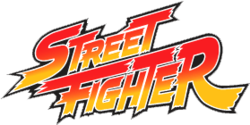
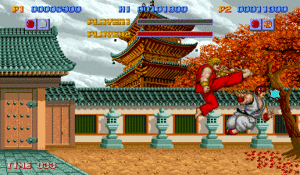
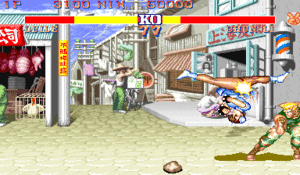
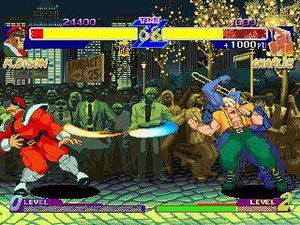
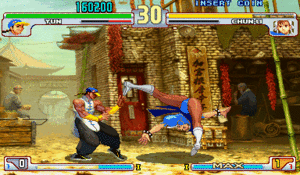
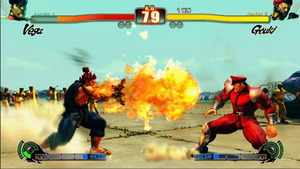








![{\displaystyle [i_{1},i_{2}...i_{h}]}](https://wikimedia.org/api/rest_v1/media/math/render/svg/cab73a91383cf4838d2b83ac035867d72a46ce48)





![{\displaystyle [o_{1},o_{2}...o_{n}]}](https://wikimedia.org/api/rest_v1/media/math/render/svg/0a2a023ac74bf4215c0d082cfcfd7157cc566d47)

